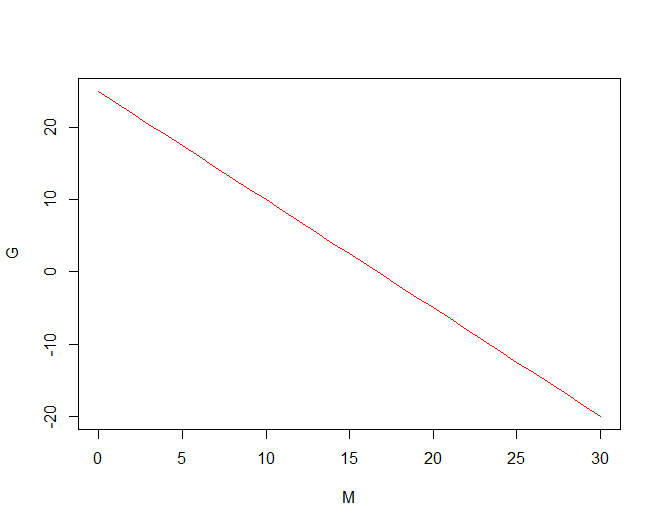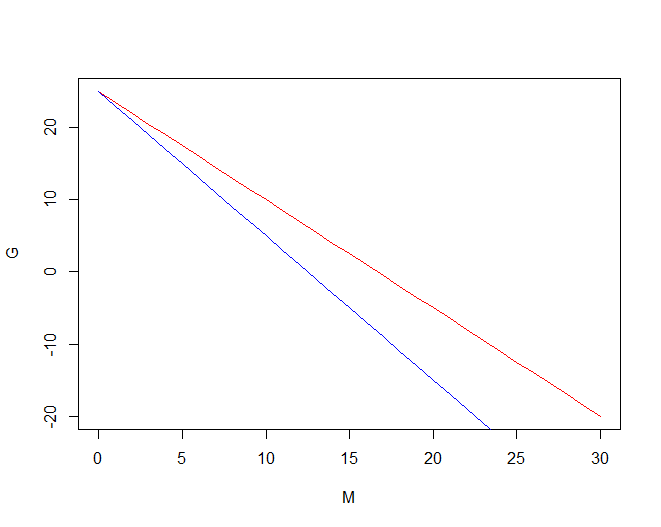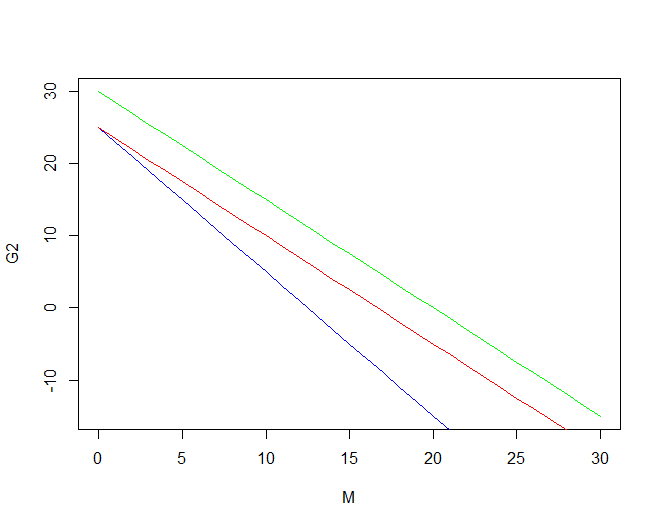Linear Equations (Economics)
Linear Equations
A linear equation is an equation which consists of only sums of variables and variables which are multiplied by a constant, with no products of variables. All of the variables in the equation must be raised to the power of one. The general form of a linear equation is: \[ax+b=0\] where $a$ and $b$ are constants and $a\neq 0$. Solving a linear equation means finding the values of $x$ which satisfy the equation (make the expression on the left-hand side of the $=$ sign equal to zero).
Examples of equations in economics which are often linear include budget constraints and demand and supply functions.
Worked Example - Linear or Nonlinear?
Decide whether the following equations are linear or nonlinear:
$ a)$ $ \text{}y = 4x^2 + 4 + 5x$
$ b)$ $\text{} 9990 = 99y - 578x $
$ c)$ $\text{}4567 = 23xy$
Solution
$a)$ This is a nonlinear equation as $x$ is squared (raised to the power of $2$).
$b)$ This is a linear equation as it is in the correct form: neither $x \text { nor } y$ is raised to a power other than one or zero and their coefficients are constants.
$c)$ This is a nonlinear equation as $x \text{ and } y$ are multiplied together: we have a product of variables.
Manipulating Equations
See the following pages for information on manipulating equations.
Solving Linear Equations in One Variable
When a linear equation has only one variable, solving the equation means finding the value(s) of the variable which satisfy the equation (make the left hand side equal to the right hand side).
Worked Example
Solve $4x-1=\dfrac{1}{3}(2+2x)$.
Solution
The aim is to collect the $x$ terms on one side and the constants on the other. Begin by multiplying through by $3$ to get rid of the fraction. \begin{align} 3 \times (4x-1) &= 3 \times \frac{1}{3}(2+2x) \\ 12x - 3 &= 2+2x \end{align}
Subtract $2x$ from both sides so that there is no $x$ term on the right. \begin{align} 12x - 3 - 2x &= 2 + 2x - 2x \\ 10x - 3 &= 2 \\ \end{align}
Add $3$ to both sides so that the $x$ term is on its own on the left. \begin{align} 10x - 3 + 3 &= 2 + 3 \\ 10x &= 5 \end{align}
Finally, divide by $10$ to get an expression for $x$. \begin{align} \frac{10x}{10} &= \frac{5}{10} \\ \\ x &= \frac{1}{2} \end{align}
Worked Example
Solve $\dfrac{3}{3-a} + \dfrac{4}{2a+1} = 0$.
Solution
Take the second fraction over to the right hand side and then cross multiply. \begin{align} \frac{3}{3-a} &= -\frac{4}{2a+1} \\ 3(2a+1) &= -4(3-a) \\ 6a+3 &=-12+4a \end{align} Subtract $4a$ from both sides. \begin{align} 6a + 3 - 4a &= -12 + 4a - 4a \\ 2a + 3 &= -12 \end{align}
Subtract $3$ from both sides. \begin{align} 2a + 3 - 3 &= -12 - 3 \\ 2a &= -15 \end{align}
Divide by $2$ to get a solution for $a$. \begin{align} \frac{2a}{2} &= - \frac{15}{2} \\ \\ a &= - \frac{15}{2} \end{align}
Economic Applications
Demand and Supply Equations
Worked Example
Suppose that the supply equation for bananas is given by $q^S=p+10$ where $q^S$ is the quantity supplied (in kilos) and $p$ is the price of bananas (in $£$ per kilo).
a) How much would be supplied at a price of $£10$?
b) If $q^S=30$, what must the price be?
Solution
a) Substituting $p=10$ into the supply equation gives: \begin{align} q^S&=p+10\\ &=10+10\\ &=20 \end{align}
So $20$ kilos of bananas would be supplied at a price of $£10$.
b) We must first rearrange the supply equation to make $p$ the subject: \begin{align} q^S&=p+10\\ \Rightarrow p&=q^S-10 \end{align}
Substituting $q^S=30$ into this rearranged equation gives: \begin{align} p&=30-10\\ &=20 \end{align} so if $30$ kilos are supplied, the price must be $£20$.
Budget Constraints
Worked Example
Joe's mum gives him $£2.50$ of pocket money every week. This week Joe decides that he wants to spend his pocket money on sweets at his local grocery store. His two favorite sweets are sugar mice and Gumdrops. At the grocery store sugar mice are $£0.15$ each and gum drops are $£0.10$ per bag.
a) Show this information as a budget constraint.
b) How many bags of Gumdrops can Joe have if he buys $2$ sugar mice?
c) Suppose that on the following week the price of a sugar mouse increases to $£0.20$. Draw the new budget constraint on the same graph and determine how many bags of Gumdrops can Joe now have if he buys $2$ sugar mice.
d) On the week of his birthday, Joe's mum gives him $£3$ of pocket money. Joe decides to buy sugar mice and Gumdrops again from the same grocery store. Assuming the prices this week are the same as in part b)), show this information as a new budget constraint on the same graph. How many bags of Gumdrops can Joe now have if he buys $2$ sugar mice?
Solution
a) The budget constraint can be expressed as a linear equation: \[2.50=0.15M+0.1G\] where $£2.50$ is the total amount of money (in $£$) Joe has to spend and $M$ and $G$ are the amount of sugar mice and bags of Gumdrops respectively that Joe buys. Rearranging the budget constraint to make $G$ the subject gives: \begin{align} 0.1G&=2.50-0.15M\\ \Rightarrow G&=\frac{2.50}{0.1}-\frac{0.15M}{0.1}\\ &=25-1.5M \end{align}
We can now plot the (rearranged) budget constraint $G=25-1.5M$:

b) We can find out how many bags of Gumdrops Joe can have if he buys $2$ sugar mice by substituting $M=2$ into the rearranged budget constraint: \begin{align} G&=25-1.5\times 2\\ &=22 \end{align}
So for $£2.50$ Joe can have $2$ sugar mice and $22$ bags of Gumdrops.
c) The budget constraint with the new price is: \[2.50=0.2M+0.1G\] Rearranging this budget constraint to make $G$ the subject gives: \begin{align} 2.50&=0.2M+0.1G\\ \Rightarrow G&=\frac{2.50}{0.1}-\frac{0.2M}{0.1}\\ &=25-2M \end{align}
We can now plot the (rearranged) budget constraint $G=25-2M$:

The new budget constraint is shown by the blue line. We can see that the higher price of sugar mice has made the budget constraint steeper: Joe must now give up more Gumdrops for each additional sugar mouse he wants to buy with his pocket money.
To find out how many bags of Gumdrops can Joe now have if he buys $2$ sugar mice we need to substitute $M=2$ into the new (rearranged) budget constraint. This gives: \begin{align} G&=25-2\times 2\\ &=21 \end{align}
So now Joe can have $2$ sugar mice and $21$ bags of Gumdrops. That is, for $£2.50$ Joe can have $1$ less bag of Gumdrops and the same number of sugar mice at the new price of sugar mice. This corresponds to our observations from the graph.
d) With his new amount of pocket money, Joe's budget constraint is given by: \[3=0.15M+0.1G\] Rearranging this budget constraint to make $G$ the subject gives: \[G=30-1.5M\]
We can now plot this rearranged budget constraint:

The new budget constraint is shown by the green line. We can see that the higher amount of pocket money has shifted Joe's budget constraint outwards (to the right): Joe can now have more sugar mice and more Gumdrops than he could with the amount of money and prices in part a).
To find out how many bags of Gumdrops can Joe now have if he buys $2$ sugar mice we need to substitute $M=2$ into the new (rearranged) budget constraint. This gives: \begin{align} G&=30-0.15\times 2\\ &=27 \end{align}
So now Joe can have $2$ sugar mice and $27$ bags of Gumdrops. For $£3$ Joe can have $5$ more bag of Gumdrops and the same number of sugar mice than with the amount of pocket money he usually receives and the prices from part a). This corresponds to our observations from the graph.
Video Examples
Example 1
Prof. Robin Johnson solves the linear equation $2x-5 = \dfrac{1}{2}(3-x)$.
Example 2
Prof. Robin Johnson solves the equation $\dfrac{2}{1-x} + \dfrac{3}{x+2} =0$.
Workbook
This workbook produced by HELM is a good revision aid, containing key points for revision and many worked examples.
Test Yourself
Test yourself: Numbas test on solving linear equations
Test yourself: Numbas test on money